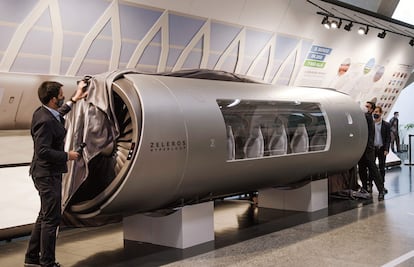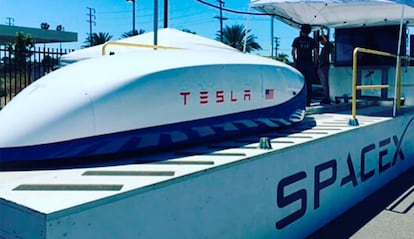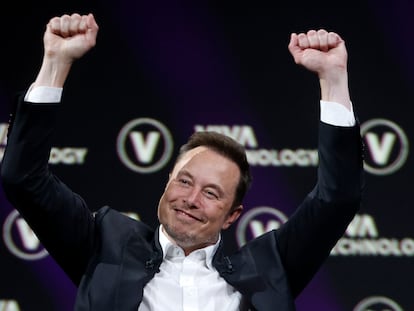The failure of the ‘hyperloop’, Elon Musk’s dream of traveling at 1,000 km/h by train that is fading
Technology that promised travel at near-supersonic speeds in capsules through vacuum tubes deflates after a decade of projects that did not come together

Ten years after Elon Musk published a paper with his proposal to travel in capsules through vacuum tubes, hyperloop has only met with failures. The new means of transport theoretically allowed reaching 1,000 km/h and up to 1,200 km/h, expectations that border on the speed of sound. But none of the trials to date have come close to this goal. At the end of 2023, one of the companies that had raised the most money to carry out the project, Hyperloop One, closed its doors. The Spanish company Zeleros, which also aspired to develop the technology, has announced that it has laid off half of its staff and will refocus its efforts on electric mobility.
For some, what happened was the chronicle of a fiasco foretold. Carlo van de Weijer, director of Intelligent Mobility at the Technical University of Eindhoven, has been one of the most critical of the system: “It is a very complicated solution in search of a problem that does not exist. Putting money into hyperloop as a serious transportation system was a stupid idea from the beginning.”
But the technology sparked a flurry of interest in its early days. Musk proposed a suggestive scenario. San Francisco-Los Angeles, a trip that takes about 6 hours by road, could be traveled in 30 minutes. The founder of Tesla and SpaceX was preceded by his image of success and vision, a factor that could stimulate investment. “Many people may have thought ‘oh wow, we’ve missed the Tesla opportunity’, which had acquired enormous value, and they must have thought that they could get on board with that new idea. And they raised a lot of capital, because it was a very attractive technology. But they completely forgot that they were not solving any problem,” says van de Weijer.
The failed Hyperloop One raised around $450 million. Its investors included Richard Branson, the billionaire founder of the Virgin technology empire, and the Emirati port operator Dubai Ports World. Another startup, also American, Hyperloop TT, had already secured around 108 million dollars for 2016. “The issue was totally green and people were buying the future,” says Manuel Romana, professor of Transportation. at the School of Civil, Canal and Port Engineers, at the Polytechnic University of Madrid (UPM). “Those who put money in wanted to jump on the bandwagon at the beginning. But there are several strong technological uncertainties about how to achieve the technology.”

The hyperloop is inspired by pneumatic tube systems, which were implemented at the end of the 19th century to send documents in large buildings. They are the same ones that are used today in some supermarkets to quickly withdraw cash from the till. “Elon Musk thought that this could be scaled to transport people and goods. But of course, the technology that existed has a diameter of centimeters,” explains the UPM transportation specialist. Hyperloop consists of vacuum tubes where capsules would be propelled to carry travelers or goods, without any impediment to progress. And this absence of friction would allow the promised very high speeds to be achieved. So far, the most basic theory.
The reality appears more complex. On a visit to the Hyperloop One facilities, Van de Weijer came away with more doubts than he already had. “I saw some fundamental problems and I was surprised that there was no serious answer to all these questions. They were spending a huge amount of money developing completely irrelevant things,” he says.
The cost is one of the difficulties that this mobility expert sees. Linear induction motors would be needed, which are propulsion systems intended to propel the capsules. And the system would require a very powerful one or many of them, placed every certain distance. Something that would be enormously expensive, as would the construction of the steel conduits necessary to support the structure of the transportation network.
Added to this is complicated planning, since hyperloop would work best with a straight line layout. “You would have to go through mountains and go through any obstacle and it is very difficult to plan this,” van de Weijer points out. Obviously, any real transportation network has detours and convergences that would be difficult to materialize. He also saw a limitation in the loading capacity. “They were talking about capsules of 14 people launched every two minutes. And they even said that they could make them for 28 people and send them every minute. The capacity was very small compared to that provided by a highway or an airline.”
In this decade all hyperloop trials have fallen far short of the concept. “There have been no publications of evolutions. The evidence that was available was nothing like the proposed system,” says Romana. In 2020, Hyperloop One did its first and only test with human passengers and the speed reached was 172 km/h.
In Spain, enthusiasm also spread. The Valencian Zeleros raised 15 million euros —even Juan Roig came in as an investor— to develop the technology. The technological-industrial group Artificial was involved in the construction of capsules, commissioned by Hyperloop TT. It had a balance receivable of 2.2 million dollars, which he converted into a package of shares in the American company. The company assures that it will focus on “the electric and connected mobility market, with real products and customers.”

Romana puts on the table a key factor for the success of any transportation project: “There are many points that were not resolved. And they must be resolved for an insurance company to accept a policy. Everything is insured. It is not conceivable that a company would risk paying what the courts say [in the event of an accident] because compensation can be very expensive. Therefore, you have to do things that are technically possible and also that the insurer sees as safe enough to accept the risk.”
Precisely the security of the system is another aspect that raises doubts. “The idea of this was that it would be possible to launch very frequent capsules, one after the other, every few minutes and at high speed,” Romana recaps. “But of course, this raises a lot of security questions. What happens when a capsule stops in an emergency? All the others have to stop in an emergency,” and he adds that this formula is complicated because a stopping distance is needed so that the capsule that follows does not crash.
Van de Weijer is even more catastrophic in his questioning: “What happens if there is a hole in the tube? The entire system could implode,” he emphasizes, referring to the force with which air from outside would enter a vacuum duct, spurred by the great difference in pressure that exists. Both specialists agree that these companies were seeking the support of public funds to develop projects that require a lot of capital. In this regard, van de Weijer is blunt: “We should not dream that there will be a hyperloop transport system nor should we invest public money in such a system.”
Sign up for our weekly newsletter to get more English-language news coverage from EL PAÍS USA Edition
Tu suscripción se está usando en otro dispositivo
¿Quieres añadir otro usuario a tu suscripción?
Si continúas leyendo en este dispositivo, no se podrá leer en el otro.
FlechaTu suscripción se está usando en otro dispositivo y solo puedes acceder a EL PAÍS desde un dispositivo a la vez.
Si quieres compartir tu cuenta, cambia tu suscripción a la modalidad Premium, así podrás añadir otro usuario. Cada uno accederá con su propia cuenta de email, lo que os permitirá personalizar vuestra experiencia en EL PAÍS.
¿Tienes una suscripción de empresa? Accede aquí para contratar más cuentas.
En el caso de no saber quién está usando tu cuenta, te recomendamos cambiar tu contraseña aquí.
Si decides continuar compartiendo tu cuenta, este mensaje se mostrará en tu dispositivo y en el de la otra persona que está usando tu cuenta de forma indefinida, afectando a tu experiencia de lectura. Puedes consultar aquí los términos y condiciones de la suscripción digital.
More information
Archived In
Últimas noticias
Most viewed
- Christian Louboutin: ‘Young people don’t want to be like their parents. And if their parents wear sneakers, they’re going to look for something else’
- ‘El Limones’ and the growing union disguise of Mexican organized crime
- Cartels in Mexico take a leap forward with narco-drones: ‘It is criminal groups that are leading the innovation race’
- The low-cost creative revolution: How technology is making art accessible to everyone
- ‘We are dying’: Cuba sinks into a health crisis amid medicine shortages and misdiagnosis










































